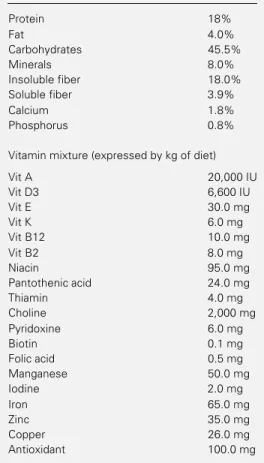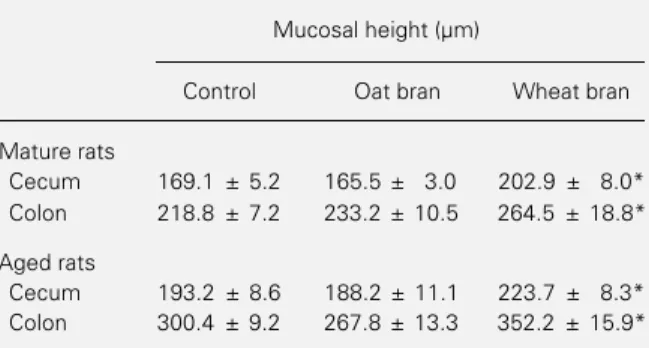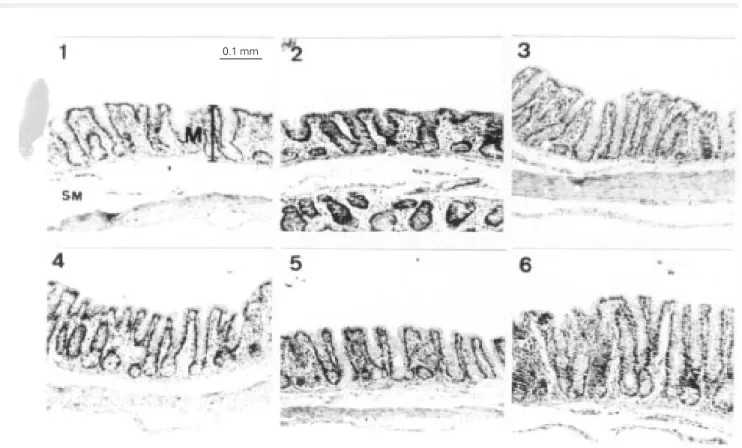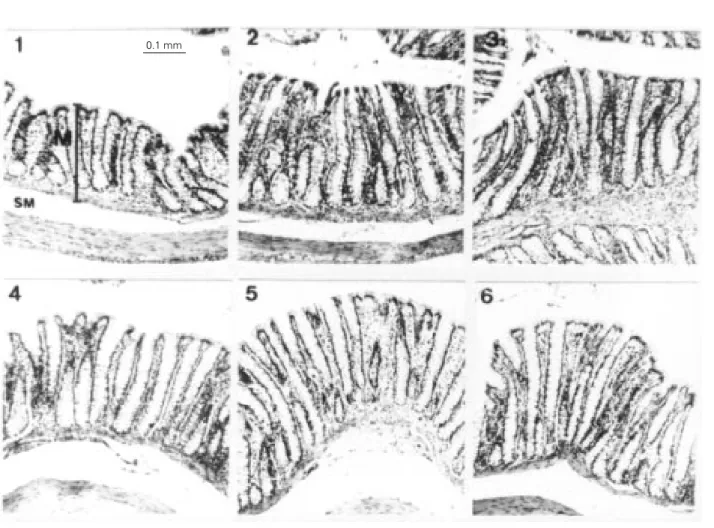Wheat bran- but not oat bran-enriched
diets increase the mucosal height of
the cecum and colon of newly
weaned and aged rats
1Departamento de Fisiologia e Biofísica, Instituto de Ciências Biomédicas,
Universidade de São Paulo, 05508-900 São Paulo, SP, Brasil
2Departamento de Ciências Biológicas, Universidade Metodista de Piracicaba,
13400-901 Piracicaba, SP, Brasil C.R. Cavaglieri-Felippe2,
M.L.O. Polacow2,
M.R. Campos2,
M.G. Vecchia2 and R. Curi1
Abstract
The effect of diets enriched with oat or wheat bran (prepared by the addition of 300 g of each fiber to 1000 g of the regular diet), given for 8 weeks, on the mucosal height of the colon and cecum was investi-gated. Newly weaned (21 days old) and aged (12 months old) male Wistar rats were used in this study. As compared to controls, diets enriched with wheat bran provoked a significant increase in the mucosal height, whereas oat bran did not cause any effect. In newly weaned rats (21 days old), wheat bran increased the mucosal height (µm) in the cecum by 20% (mean ± SEM for 8 rats; 169.1 ± 5.2 and 202.9 ± 8.0 for control and wheat bran, respectively) and in the colon (218.8 ± 7.2 and 264.5 ± 18.8 for control and wheat bran, respec-tively). A similar effect was observed in aged rats (12 months old), with an increase of 15% in the mucosal height (µm) of the cecum (mean ± SEM of 8 rats; 193.2 ± 8.6 and 223.7 ± 8.3 for control and wheat bran, respectively) and of 17% in the colon (300.4 ± 9.2 and 352.2 ± 15.9 for control and wheat bran, respectively).
Correspondence
R. Curi
Laboratório de Fisiologia Celular Departamento de Fisiologia e Biofísica, ICB, USP Av. Prof. Lineu Prestes, 1524 05508-900 São Paulo, SP Brasil
Fax: 55 (011) 818-7285 E-mail: ruicuri@bmb.icb1.usp.br Research supported by FAPESP (No. 93/3498-4), FAP-UNIMEP and CNPq.
Received October 18, 1996 Accepted June 13, 1997
Key words
•Oat bran •Wheat bran •Colon •Cecum •Mucosa •Ageing
Introduction
The greatest protection associated with high fiber intake is that against gastrointesti-nal disorders. In 1980, the Royal College of Physicians (1) reviewed the potential protec-tive role of fibers against gallstones, func-tional bowel disorders, diverticular disease of the colon, colon cancer, appendicitis, hem-orrhoids, and hiatal hernia. Although a full link between these conditions and fiber-de-pleted diets has not been established,
(6) postulated that dietary fiber has a viscos-ity-related trophic effect in the small bowel and a fermentation-related trophic effect in the colon. SCFA are mainly produced by fermentation of water-soluble fibers and play a role as a metabolic fuel for the colon (5), stimulate mucosal proliferation (7), and in-crease sodium and water absorption (8). Be-cause the generation of SCFA has been as-sumed to be the main mechanism for the intestinal function of fibers, a number of studies have been developed to examine the effect of these acids on cell proliferation and differentiation. Butyrate provokes a marked inhibition of the growth of several tumor cell lines in culture (9). A recent study from our laboratory has shown that propionate, at con-centrations ranging from 1 to 5 mM, also inhibits the proliferation of tumor (HeLa-155 and KB-172) and normal (MA-104) cell lines in vitro (10). In addition, propionate
has been shown to stimulate lymphocyte proliferation at low concentrations (40 µM and 0.1 mM) but to inhibit it at concentra-tions above 1 mM (11). Intracolonic infu-sion of SCFA increases mucosal weight and the protein and DNA content of the proximal colon (12). Experiments carried out on parenterally nourished rats have shown that SCFA infusion into the colon promotes a modest increase in mucosal height and mu-cosal DNA content but does not influence absorption (13).
In spite of the reports mentioned above, it is not known whether the effect of a water-soluble fiber-enriched diet (the main source of SCFA) on the mucosa of the large bowel is more pronounced than that of an insoluble fiber-enriched diet. In the present study, we determined the effect of fiber-rich diets on the mucosal height of the colon and cecum. Rats received two types of fiber-rich diets presenting different soluble/insoluble ratios for 8 weeks, i.e., oat bran (0.3) and wheat bran (0.14). To better characterize the effect of the fiber-rich diets on the intestinal mu-cosa, the experiments were carried out on newly weaned (21 days old) and aged (12 months old) rats.
Material and Methods
Animals and diet preparation
Newly weaned (21 days old) male Wistar rats weighing 50-60 g and aged rats (12 months old) weighing 310-330 g were ob-tained from the Animal House of the Insti-tute of Biomedical Sciences, USP, São Paulo. During the experiment, the rats were kept in groups of 5 animals at 23oC on a 12-h light/ 12-h dark cycle (lights on at 7:00 a.m.). Newly weaned and aged rats were divided into three groups: 1) control rats were fed a regular diet whose composition is shown in Table 1, 2) the oat bran-enriched diet was prepared by the addition of 300 g of oat bran to 1000 g of the regular diet, and 3) the wheat
Table 1 - Basic composition of the regular diet.
Protein 18%
Fat 4.0%
Carbohydrates 45.5%
Minerals 8.0%
Insoluble fiber 18.0%
Soluble fiber 3.9%
Calcium 1.8%
Phosphorus 0.8%
Vitamin mixture (expressed by kg of diet)
Vit A 20,000 IU
Vit D3 6,600 IU
Vit E 30.0 mg
Vit K 6.0 mg
Vit B12 10.0 mg
Vit B2 8.0 mg
Niacin 95.0 mg
Pantothenic acid 24.0 mg
Thiamin 4.0 mg
Choline 2,000 mg
Pyridoxine 6.0 mg
Biotin 0.1 mg
Folic acid 0.5 mg
Manganese 50.0 mg
Iodine 2.0 mg
Iron 65.0 mg
Zinc 35.0 mg
Copper 26.0 mg
bran-enriched diet was prepared by the addi-tion of 300 g of wheat bran to 1000 g of the regular diet. The soluble/insoluble fiber ra-tio was 0.22, 0.30 and 0.14 for control, oat bran and wheat bran-enriched diets, respec-tively. During the 8 weeks on the respective diets, body weight, daily food intake and feces elimination were evaluated weekly. After this period, now mature (previously called newly weaned) and aged rats were killed by decapitation without anesthesia and the colon and cecum were removed. The experiments were always carried out be-tween 8:00 and 11:00 h.
Measurement of mucosal height of the colon and cecum
Segments of the cecum and colon were kept in 10% formalin solution and processed for paraffin embedding, and 7-µm thick slices were stained with hematoxylin-eosin. The height of the cecum and colon mucosa was determined in 8 rats, 3 sections per rat, and 10 different areas per section. The mucosal height was measured in areas formed by a single cell layer with the base of the crypt being in direct contact with the muscular mucosa. All measurements were carried us-ing an ocular micrometer (Ernest Leitz, Wetzpar, Germany).
Statistical analysis
Data were analyzed statistically by ANOVA and by the Student t-test. The level of significance was set at P<0.05.
Results
The body weight gain of mature rats fed the oat bran-enriched diet did not differ from the control group. However, the body weight of mature rats fed the wheat bran-enriched diet was 18% lower than control at the end of the 8-week period (data not shown). The body weight gain of aged rats was not
modi-fied by either fiber-rich diet. Daily food in-take and feces dry weight did not differ between groups (P<0.05).
The wheat bran-enriched diet provoked a significant increase in mucosal height, whereas oat bran did not cause any effect compared to control (Table 2). In mature rats, wheat bran increased the mucosal height in cecum and colon by 20%. A similar effect was observed in aged rats, with an increase of 15% in the cecum and of 17% in the colon. Photomicrographs of cecum and colon mu-cosa provide additional evidence of these findings (portions 3 and 6 of Figures 1 and 2).
Discussion
Volatile short-chain fatty acids are the major solute fraction of fecal water pro-duced by fermentation of fibers by anaerobic bacteria normally residing in the large bowel (14). These fatty acids are known to have a trophic effect on the large bowel and the response to the different fibers suggests that the more readily fermentable fibers have the greatest effect (6). Several studies have pre-sented evidence that acetate, propionate and mainly butyrate raise DNA synthesis in the
Table 2 - Effect of soluble (oat bran) and insoluble (wheat bran) fiber-rich diets on the mucosal height of colon and cecum of mature and aged rats.
For details of diet preparation and measurement of the mucosal height see Material and Methods. Data are reported as the mean ± SEM of 8 rats. *P<0.05 compared to the control group (Student t-test).
Mucosal height (µm)
Control Oat bran Wheat bran
Mature rats
Cecum 169.1 ± 5.2 165.5 ± 3.0 202.9 ± 8.0* Colon 218.8 ± 7.2 233.2 ± 10.5 264.5 ± 18.8*
Aged rats
Figure 1 - Photomicrographs of the cecum mucosa from mature (1, 2 and 3) and aged (4, 5 and 6) rats fed a control diet (1 and 4) or diets enriched with oat bran (2 and 5) or wheat bran (3 and 6). The tissues were prepared as described in Material and Methods and stained with hematoxylin and eosin (X100). The mucosal height is indicated by the vertical bar. The horizontal magnification bar corresponds to 0.1 mm. M, Mucosa; SM, submucosa.
intestinal mucosa (15). In addition, these SCFA are also fuels for these cells (5)and this fact might be important in the control of epithelial cell proliferation. In spite of this, however, there are several trophic factors which can effectively control the mainte-nance of the intestinal epithelium such as 1) blood flow to the tissue (16), 2) motility of the intestine (17), 3) trophic hormones such as enteroglucagon (18), 4) conditions of the lumen such as the presence of biliary salts (19), and 5) amines produced by bacteria metabolism.
The stimulating effect of the SCFA on cell proliferation should be considered with concern. In fact, there is evidence that these fatty acids are potent inhibitors of cell prolif-eration at high concentrations. Butyrate has been shown to reduce tumor development (9) and to promote apoptosis of colonic car-cinoma cells (20,21)and of the myeloid
HL-60 cell line (22). Also, the development of colorectal cancer has been inversely corre-lated with the amount of butyric acid in the feces (23). Propionate stimulates lympho-cyte proliferation at concentrations up to 1 mM but provokes a marked inhibition at concentrations above 2 mM (11). This SCFA also inhibits the proliferation of several tu-mor cell lines (10). Several mechanisms have been postulated to be involved in the control of cell proliferation by SCFA such as inhibi-tion of oncogene expression (24,25), stimu-lation of polyamine biosynthesis (26) and reduction of lipid synthesis (27).
The production of SCFA in the gas-trointestinal tract results mainly from water-soluble dietary fibers. The water-soluble/inwater-soluble fiber ratios of the fiber-rich diets used in this study were 0.30 for oat bran and 0.14 for wheat bran. Therefore, the oat bran-enriched diet presents a 2-fold higher capacity than
the wheat bran-enriched diet for the produc-tion of SCFA.
Jacobs and White (28) showed that in rats fed wheat bran (20% dietary supplemen-tation) for 9 weeks there is decreased exfo-liation and cell migration in the cecum, whereas cell proliferation and cell migration increase in the colon. Indeed, wheat bran did present a significant effect on the large intes-tine mucosa which was clearly more pro-nounced than that of oat bran (Table 2 and Figures 1 and 2). Whether these changes are due to decreased exfoliation and cell migra-tion or to increased cell proliferamigra-tion and cell migration remains to be investigated. This effect of wheat bran was observed in both newly weaned and aged rats. Similarly,
Goodlad et al. (29) showed that refeeding of 3-day starved rats with wheat bran-enriched diet causes a large proliferative response in the proximal, mid-, and distal colon. These findings led us to postulate that the changes in the large intestine epithelium induced by fiber-rich diets do not depend exclusively on the amount of short-chain fatty acids pro-duced. In fact, wheat bran (a poor SCFA producer) did increase the mucosal height of the colon and cecum, whereas oat bran (a high SCFA producer) did not significantly affect the mucosa. Other factors may play a role in the present observations such as an increase in the motility and blood flow of the intestine, and secretion of entero-hormones.
Figure 2 - Photomicrographs of the colon mucosa from mature (1, 2 and 3) and aged (4, 5 and 6) rats fed a control diet (1 and 4) or diets enriched with oat bran (2 and 5) or wheat bran (3 and 6). The tissues were prepared as described in Material and Methods and stained with hematoxylin and eosin (X100). The mucosal height is indicated by the vertical bar. The horizontal magnification bar corresponds to 0.1 mm. M, Mucosa; SM, submucosa.
Acknowledgments
The authors are grateful to Dr. E.A. Newsholme for constant encouragement and
to W.M.S. Nunes, G. de Souza, J.R. Mendonça and M. Carnelós Filho for techni-cal assistance.
References
1. A Report of the Royal College of Physi-cians (1980). Medical Aspects of Dietary Fibre. Pitman Medical, London, 93-139. 2. Sircar B, Johnson LR & Lichtenberger LM
(1983). Effect of synthetic diets on gas-trointestinal mucosal DNA synthesis in rats. American Journal of Physiology, 244: G327-G335.
3. Jacobs LR & Lupton JR (1984). Effect of dietary fibers on rat large bowel mucosal growth and cell proliferation. American Journal of Physiology, 246: G378-G385. 4. Dowling RH, Riecken EO & Laws JW
(1967). The intestinal response to high-bulk feeding in the rat. Clinical Science, 32: 1-9.
5. Bergmann EN (1984). Energy contribu-tions of volatile fatty acids from the gas-trointestinal tract in various species. Physi-ological Reviews, 70: 567-590.
6. Pell JD, Johnson IT & Goodlad RA (1995). The effects of and interactions between fermentable dietary fiber and lipid in germ-free and conventional mice. Gastroenter-ology, 108: 1745-1752.
7. Sakata T (1984). Short-chain fatty acids as the luminal trophic factor. Canadian Jour-nal of Animal Science, 64: 189-190. 8. Binder JH & Mehta P (1989). Short-chain
fatty acids stimulate active sodium and chloride absorption in vitro in the rat distal colon. Gastroenterology, 96: 989-996. 9. Galfi P, Neogrady S & Kutas F (1991). The
inhibitory action of sodium butyrate on the growth of KB, MMT and RPMI cells. Veterinary Research Communications, 15: 261-269.
10. Vecchia MG, Arizawa S, Curi R & Newsholme EA (1992). Propionate inhib-its cell proliferation in culture. Cancer Re-search Therapy and Control, 3: 15-21. 11. Curi R, Bond JA, Calder PC & Newsholme
EA (1993). Propionate regulates lympho-cyte proliferation and metabolism. Gen-eral Pharmacology, 24: 591-597. 12. Scheppach W, Bartram HP & Richter F
(1995). Role of short-chain fatty acids in the prevention of colorectal cancer. Euro-pean Journal of Cancer, 31A: 1077-1080.
13. Friedel D & Levine GM (1992). Effect of short-chain fatty acids on colonic function and structure. Journal of Parenteral and Enteral Nutrition, 16: 1-4.
14. Stark AH & Madar Z (1993). In vitro pro-duction of short-chain fatty acids by bac-terial fermentation of dietary fiber com-pared with effects of those fibers on he-patic sterol synthesis in rats. Journal of Nutrition, 123: 2166-2173.
15. Scheppach W (1994). Effects of short chain fatty acids on gut morphology and function. Gut, 1: S35-S38.
16. Demigne C & Remesy C (1985). Stimula-tion of absorpStimula-tion of volatile fatty acids and minerals in the cecum of rats adapted to a very high-fiber diet. Journal of Nutri-tion, 115: 53-60.
17. Kamath PS, Hepfner MT & Phillips SF (1987). Short-chain fatty acids stimulate motility of the canine ileum. American Journal of Physiology, 253: G427-G433. 18. Goodlad RA, Lenton W & Ghatei MA
(1987). Proliferation effect of fiber on the intestinal epithelium: relationship to gastrin enteroglucagon, and PYY. Gut, 28: 221-226.
19. DeRobertis FR, Craven PA & Saito R (1984). Bile salt stimulation of colonic epi-thelial proliferation. Journal of Clinical In-vestigation, 74: 1614-1624.
20. Heerdt BG, Houston MA & Augenlicht LH (1994). Potentiation by specific short-chain fatty acids of differentiation and ap-optosis in human colonic carcinoma cell lines. Cancer Research, 54: 3288-3293. 21. Hague A, Elder DJ, Hicks DJ & Paraskeva
C (1995). Apoptosis in colorectal tumour cells: induction by the short-chain fatty acids butyrate, propionate and acetate and the bile salt deoxycholate. International Journal of Cancer, 60: 400-406. 22. Calabresse C, Venturini L, Ronco G, Villa
P, Chomienne C & Belpomme D (1993). Butyric acid and its monosaccharide ester induce apoptosis in the HL-60 cell line. Biochemical and Biophysical Research Communications, 195: 31-38.
23. Folino M, McIntyre A & Young GP (1995). Dietary fibers differ in their effects on large bowel epithelial proliferation and fe-cal fermentation-dependent events in rats. Journal of Nutrition, 125: 1521-1528. 24. Hague A, Manning AM, Hanlon KA, Huschtscha LI, Hart D & Paraskeva C (1993). Sodium butyrate induces apopto-sis in human colonic tumour cell lines in a p53-independent pathway: implications for the possible role of dietary fibre in the prevention of large-bowel cancer. Interna-tional Journal of Cancer, 55: 498-505. 25. Heruth DP, Zirnstein GW, Bradley JF &
Rothberg PG (1993). Sodium butyrate causes an increase in the block to tran-scriptional elongation in the c-myc gene in SW837 rectal carcinoma cells. Journal of Biological Chemistry, 268: 20466-20472.
26. Parekh D, Saydjari R, Ishizuka J, Townsend Jr CM & Thompson JC (1992). Sodium butyrate stimulates polyamine biosynthesis in colon cancer cells. Surgi-cal Oncology, 1: 315-322.
27. Curi R, Costa Rosa LFBP, Yano M, Homem de Bittencourt Jr PI, Bond J & Newsholme EA (1994). The effect of pro-pionate on lipid metabolism in rat lympho-cyte. General Pharmacology, 25: 1411-1416.
28. Jacobs LR & White FA (1983). Modulation of mucosal cell proliferation in the intes-tine of rats fed a wheat bran diet. Ameri-can Journal of Clinical Nutrition, 37: 945-953.



